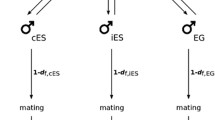Abstract
The cestode Schistocephalus solidus is a facultatively self-fertilising simultaneous hermaphrodite. Here we test for differences in the starting point, the rate, and the magnitude of egg production between individuals allowed to reproduce alone (only self-fertilisation possible) or in pairs (both self- and cross-fertilisation possible). Specifically, we want to distinguish between alternative processes responsible for the lower egg production in paired individuals observed in an earlier study (Wedekind et al., 1998). We designed an improved in vitro system, replacing the bird final host that allows us to measure, with high temporal resolution, the timing and magnitude of lifetime egg production of worms in these two social situations. We found that the experimental groups did not differ significantly in the starting point of egg production. However, the temporal pattern in egg production differed between them, in that paired individuals had a lower rate of egg production. This, however, did not lead to a significant reduction in lifetime egg production, as pairs compensated for the lower rate by producing eggs longer than single individuals. We argue that the lower rate of egg production may nevertheless lead to a time cost of pairing in the study species, and that this cost is likely to represent a cost of outcrossing due to sexual selection.
Similar content being viewed by others
References
Andersson, M. and Iwasa, Y. (1996) Sexual selection. Trends Ecol. Evol. 11, 53–58.
Charlesworth, D. and Charlesworth, B. (1987) Inbreeding depression and its evolutionary consequences. Ann. Rev. Ecol. Syst. 18, 237–268.
Charnov, E.L. (1979) Simultaneous hermaphroditism and sexual selection. Proc. Natl. Acad. Sci. USA 76, 2480–2484.
Charnov, E.L. (1982) The Theory of Sex Allocation. Princeton University Press, Princeton, NJ, USA.
Coulter Electronics Limited. (1994) Coulter MultiSizer II, Reference Manual 9912433-C. Coulter Electronics Limited, Luton, England.
Cunningham, E.J.A. and Birkhead, T.R. (1998) Sex roles and sexual selection. Anim. Behav. 56, 1311–1321.
Ghiselin, M.T. (1969) The evolution of hermaphroditism among animals. Q. Rev. Biol. 44, 189–208.
Greeff, J.M. and Michiels, N.K. (1999a) Low potential for sexual selection in simultaneously hermaphroditic animals. Proc. R. Soc. Lond. B 266, 1671–1676.
Greeff, J.M. and Michiels, N.K. (1999b) Sperm digestion and reciprocal sperm transfer can drive hermaphrodite sex allocation to equality. Am. Nat. 153, 421–430.
Hopkins, C.A. (1952) Studies on cestode metabolism. II. The utilization of glycogen by Schistocephalus solidus in vitro. Exp. Parasitol. 1, 196–213.
Hopkins, C.A. and Smyth, J.D. (1951) Notes on the morphology and life history of Schistocephalus solidus (Cestoda: Diphyllobothriidae). Parasitology 41, 283–291.
Jarne, P. and Charlesworth, D. (1993) The evolution of the selfing rate in functionally hermaphrodite plants and animals. Ann. Rev. Ecol. Syst. 24, 441–466.
Jarne, P. and Delay, B. (1990) Inbreeding depression and self-fertilisation in Lymnaea peregra (Gastropoda: Pulmonata). Heredity 64, 169–175.
Leonard, J.L. and Lukowiak, K. (1984) Male-female conflict in a simultaneous hermaphrodite resolved by sperm trading. Am. Nat. 124, 282–286.
Lewis, W.M.J. (1987) The cost of sex. In S.C. Stearns (ed) The evolution of sex and its consequences. Birkhäuser Verlag, Basel, Switzerland, pp. 33–57.
Lloyd, D.G. (1980) Benefits and handicaps of sexual reproduction. Evol. Biol. 13, 69–107.
McCaig, M.L.O. and Hopkins, C.A. (1963) Studies on Schistocephalus solidus. II. Establishment and longevity in the definitive host. Exp. Parasitol. 13, 273–283.
Michiels, N.K. (1998) Mating conflicts and sperm competition in simultaneous hermaphrodites. In T.R. Birkhead and A.P. Møller (eds) Sperm competition and sexual selection. Academic Press, London, England, pp. 219–254.
Nollen, P.M. (1975) Studies on the reproductive system of Hymenolepis diminuta using autoradiography and transplantation. J. Parasitol. 61, 100–104.
Nollen, P.M. (1983) Patterns of sexual reproduction among parasitic platyhelminths. Parasitology 86, 99–120.
Nollen, P.M. (1997) Mating behaviour of Echinostoma caproni and E. trivolvis in concurrent infections in hamsters. Int. J. Parasitol. 27, 71–75.
Rice, W.R. and Gaines, S.D. (1994) 'Heads I win, tails you lose': testing directional alternative hypotheses in ecological and evolutionary research. Trends Ecol. Evol. 9, 235–237.
Ricklefs, R.E. (1967) A graphical method of fitting equations to growth curves. Ecology 48, 978–983.
Sall, J. and Lehman, A. (1996) JMP Start Statistics: A Guide to Statistical and Data Analysis using JMP and JMPIN Software. Duxbury Press, Belmont, USA.
Schmitt, J. and Ehrhardt, D.W. (1990) Enhancement of inbreeding depression by dominance and suppression in Impatiens capensis. Evolution 44, 269–278.
Smyth, J.D. (1946) Studies on tapeworm physiology. I. The cultivation of Schistocephalus solidus in vitro. J. Exp. Biol. 23, 47–73.
Smyth, J.D. (1952) Studies on tapeworm physiology. VI. Effect of temperature on the maturation in vitro of Schistocephalus solidus. J. Exp. Biol. 29, 304–309.
Smyth, J.D. (1954) Studies on tapeworm physiology. VII. Fertilization of Schistocephalus solidus in vitro. Exp. Parasitol. 3, 64–71.
Tierney, J.F. and Crompton, D.W.T. (1992) Infectivity of plerocercoids of Schistocephalus solidus (Cestoda: Ligulidae) and fecundity of the adults in an experimental definitive host, Gallus gallus. J. Parasitol. 78, 1049–1054.
Tomlinson, J. (1966) The advantage of hermaphroditism and parthenogenesis. J. Theor. Biol. 11, 54–58.
Trouvé, S., Jourdane, J., Renaud, F., Durand, P. and Morand, S. (1999) Adaptive sex allocation in a simultaneous hermaphrodite. Evolution 53, 1599–1604.
Trouvé, S., Renaud, F., Durand, P. and Jourdane, J. (1996) Selfing and outcrossing in a parasitic hermaphrodite helminth (Trematoda, Echinostomatidae). Heredity 77, 1–8.
Wedekind, C. (1997) The infectivity, growth, and virulence of the cestode Schistocephalus solidus in its first intermediate host, the copepod Macrocyclops albidus. Parasitology 115, 317–324.
Wedekind, C. and Rüetschi, A. (2000) Parasite heterogeneity affects infection success and the occurrence of within-host competition: an experimental study with a cestode (preprint edition). Evol. Ecol. Res. 〈http://www.evolutionary-ecology.com/forthcoming.html〉
Wedekind, C., Strahm, D. and Schärer, L. (1998) Evidence for strategic egg production in a hermaphroditic cestode. Parasitology 117, 373–382.
Williams, H.H. and McVicar, A. (1968) Sperm transfer in tetraphyllidea (Platyhelminthes: Cestoda). Nytt Mag. Zool. 16, 61–71.
Author information
Authors and Affiliations
Rights and permissions
About this article
Cite this article
Schärer, L., Wedekind, C. Lifetime reproductive output in a hermaphrodite cestode when reproducing alone or in pairs: a time cost of pairing. Evolutionary Ecology 13, 381–394 (1999). https://doi.org/10.1023/A:1006789110502
Issue Date:
DOI: https://doi.org/10.1023/A:1006789110502




